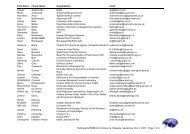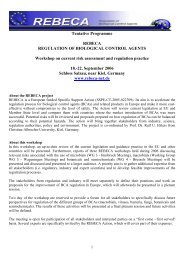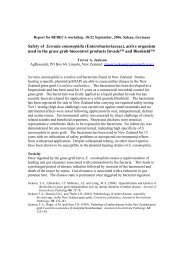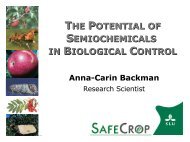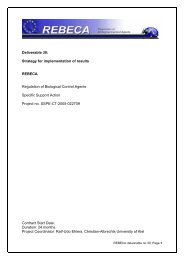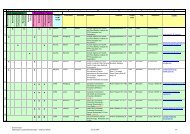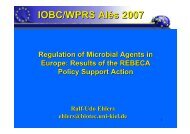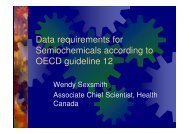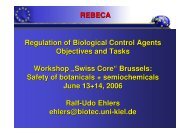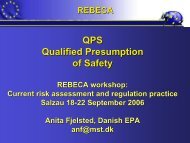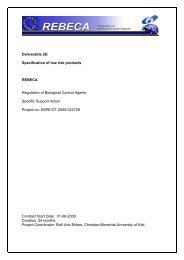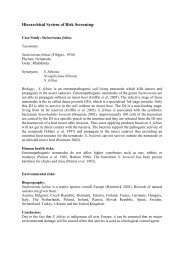EPA: Bacillus subtilis Strain QST 713 (006479) BRAD - REBECA
EPA: Bacillus subtilis Strain QST 713 (006479) BRAD - REBECA
EPA: Bacillus subtilis Strain QST 713 (006479) BRAD - REBECA
- No tags were found...
Create successful ePaper yourself
Turn your PDF publications into a flip-book with our unique Google optimized e-Paper software.
<strong>EPA</strong>: <strong>Bacillus</strong> <strong>subtilis</strong> <strong>Strain</strong> <strong>QST</strong> <strong>713</strong> (<strong>006479</strong>) <strong>BRAD</strong>conditionally required. The registrant must submit a protocol for <strong>EPA</strong> review before initiating the study.Nineteen individuals who participated in field trials of the end-use product of this active ingredient,Serenade TM WP Biofungicide submitted letters attesting that they observed no negative effect tobees. The field testing performed was designed to research efficacy and phytotoxicity. In many butnot all cases a hive was located at the sites at time of treatment. <strong>EPA</strong> contacted the individualresearchers to obtain clarification and locate beekeepers whose bees were exposed to the microbialproduct. None of these were formal studies designed to investigate the effects this microbial productmay have on honeybees. However, their observations and of the beekeepers who had hives exposedto <strong>Bacillus</strong> <strong>subtilis</strong> strain <strong>QST</strong> <strong>713</strong> provide some information about its lack of reported effects to beesin actual field conditions. A summary of the information collected is below.BEEKEEPER INTERVIEW SUMMARYThree beekeepers whose bees were exposed at field trials of Serenade report that no problems werenoted. They all indicated that written records were not usually taken unless a problem was noted.One of them reported giving special examination to a hive because of a hive kill one mile away whereinsecticides were applied. In addition, hives are subject to inspection by county or state bee agents.Due to the migratory nature of this profession, there were difficulties locating other beekeepers.SUMMARY OF LETTERS AND INTERVIEWS OF RESEARCHERSNineteen agricultural researchers submitted letters. Several indicated some applications were madeat bloom. They reported:1) No increase of honeybee mortality was observed in the field or by the hives;2) No difference in foraging or activity before and after application;3) Honeybees were not avoiding material;4) No negative effects on pollination observed at apple, pear, cherry, cucurbit,strawberry, grape. snap beans, bell pepper, potato, and watermelon;5) Cucurbits which are entirely dependent on bees for pollination produced normalyields; And6) They received no complaints from beekeepers or orchardist.2. Parasitic hymenoptera<strong>QST</strong> Technical was shown to cause mortality to parasitic Hymenoptera (Nasonia vitripennis). Thedietary LC 50 for 15 days was calculated as being approximately 28,000 ppm by the moving averagemethod with 95 percent confidence intervals of approximately 18,000 ppm and 51,000 ppm. TheLOEC was 600 ppm. Estimated environmental concentrations (EECs) were estimated via the Keneganomogram which provides expected residue levels on terrestrial food/feed items. Based on a singleapplication at the 10 lb product /acre, the EECs for the technical grade active ingredient are 250 ppmand 115 ppm. Thus, the LC 50 of 28,000 ppm is approximately one hundred and twelve (112) timesthe EEC based on foliar residue. Parasitic wasps directly sprayed with <strong>QST</strong> <strong>713</strong> would be exposed tofile:///J|/<strong>REBECA</strong>/Meetings/1.%20Conference/<strong>REBECA</strong>%...up%20work%20bacteria%20fungi/epaprintonly.cgi.html (16 von 29)13.09.2006 18:40:13



